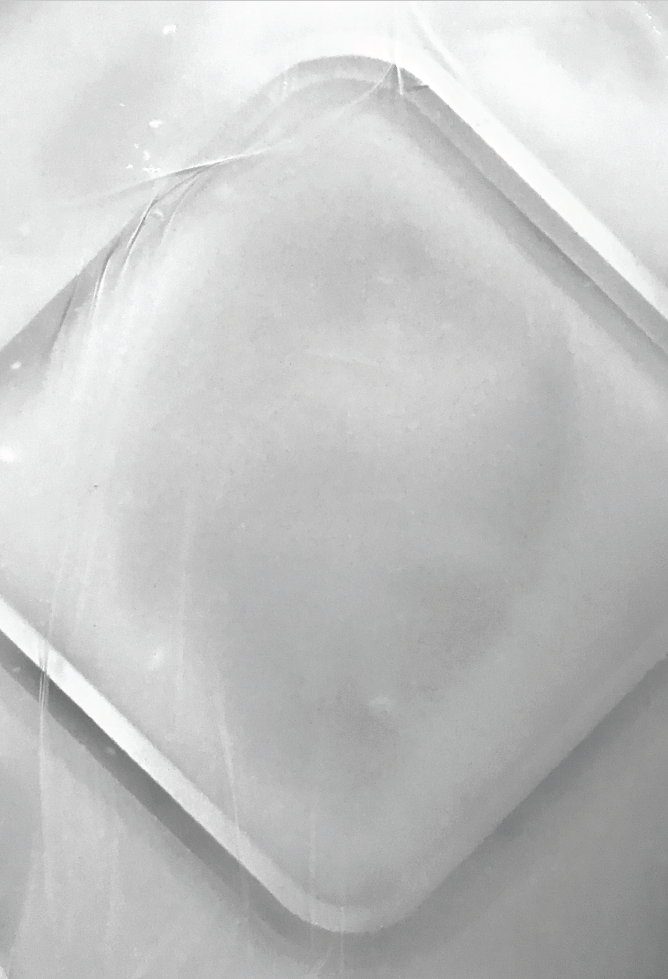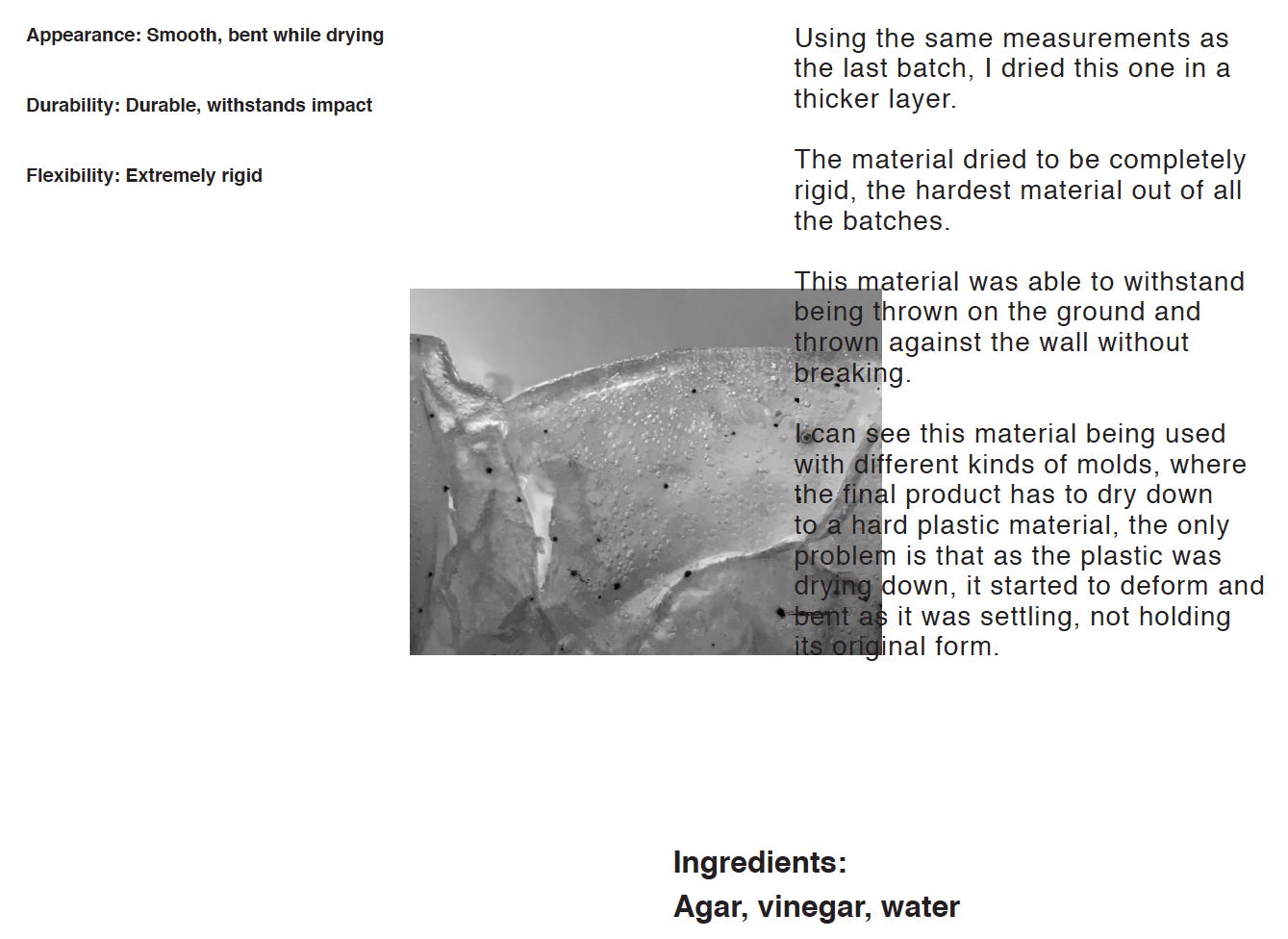A FIELD GUIDE TO MAKING BIOPLASTICS AND OVERTHROWING AN INDUSTRIAL CAPITALIST SYSTEM (WITH EASY-TO-FOLLOW VISUAL INSTRUCTIONS) 2019
Photography, print, book-bindingEvery little effort counts when it comes to stopping, or at the very least, slowing down climate change, but another thing that’s important to remember is that the industry behind plastic production is only going to grow from here. It’s important that we do what we can as individuals, but it’s also important to remember that the industry giants will not stop producing what makes them profit just because you own a metal straw and a canvas tote bag.
I do believe that a lot of the waste issue could improve based on the actions of everyday consumers, but I also do believe that a lot of actions that we can take as consumers are only surface level, visible, and comforting gestures. Climate change is way bigger than us, and regulations have to be enforced on a larger scale if we want to see any result.
There is almost nothing quite as bad as the waste problem,and especially more specifically, the plastic waste problem. Right now the approach we should take with plastic waste is to reuse, shred and remold, and this is something that we should take action with immediately. Even though that waste, landfills, and marine pollution are all things that we know is killing the planet and all of us on it, large corporations and manufacturers are not going to stop continuing to produce plastic.
As of 2018, the fossil fuel industry was estimated to be worth $4.65 trillion dollars. Today, Exxon Mobil alone is worth $308 billion dollars. According to the Center for International Environmental Law (CIEL), over 99% of plastic is made from fossil fuels and confirms that the plastic and fossil fuel industry are deeply connected. Meaning that the plastic and fossil fuel industry will have to go hand in hand when it comes to transitioning and phasing out the production of plastic.
While we continue to tackle the waste issue, we shouldn’t just ignore the fact that plastic is still being produced at an extremely large scale, and is only expected to go up from here. Currently, an estimate of 8% of the world’s oil is being used to produce plastic and is only expected to grow from here, to an estimated 20% within the next 30 years.
Despite the large cultural shift around the world encouraging consumers to be more sustainable and environmentally friendly (by no longer using single-use plastics), new plastic production facilities are still being invested in by both the plastic and fossil fuel industry for hundreds of billions of dollars. No matter what, at least for the next decade, these manufacturers will only continue to produce more plastic, and continue to burn fossil fuel. Why does the plastic industry continue to produce by using harmful resources like fossil fuels and NGLs, when there are more sustainable alternatives to producing plastic that we know about? Is it really that much more expensive and complicated to make?
I do still firmly believe that as individuals, we should all try our best to reduce and stop our use of plastic and reduce the waste we produce as consumers. However, I feel like, in order to make a huge enough impact, we should be targeting plastic manufacturers, facilities, and the industry as a whole in order to make a significant enough change. Because they will continue to produce plastic, and will continue to abuse our natural resources, and will continue to destroy our ozone, and will continue to create more waste as we’re already going nowhere with the current waste we already have.
In this book, I attempt to make different variations of plant-based bio-plastics and test the durability, reaction to different scenarios, and the rigidness and flexibility of each batch. From that, I will list the potential products that could be made from each batch. I’m avoiding bio-plastics that involve any kind of animal or animal by-products because it’s just not really a sustainable option, and plant-based materials should be easier to biodegrade. If this is something that I can make in a $10 pot in my kitchen, I don’t think it can be that much more complicated to produce on a larger scale—combatting the issues behind the toxic production of plastic, and also help with the future process of waste degradation, which is now completely ineffective, toxic, and is easily another example of systematic inequality.
Looking at the way that biggest industries and corporations currently operate, the production of plastic goods is not likely to stop or even slow down anytime soon. The waste that we continue to create will never fully break down, but rather turn into microplastics that will become embedded in animals by respiration or ingestion. Plastic’s inability to completely degrade is a critical issue affecting many ecosystems, as well as the incomprehensible amount of waste that is produced every day and is either dumped in landfills, the ocean and sent to third world countries. Besides that, we also can’t forget that plastic is still continuing to be produced and fossil fuels are still being burnt. Just earlier this year in 2019, Trump claimed that the United States has “unleashed a revolution in American energy — the United States is now the No. 1 producer of oil and natural gas in the world.” This contradicts what oil companies have been saying for years, as industry giants are funding environmental campaigns and research groups to sway media coverage. For example, Exxon Mobil invested $10 million dollars annually for 10 years in the GCEP, or Stanford University’s Global Climate and Energy Project. Just Exxon Mobil itself is expecting a 25% growth within the next five years only.
Even though we are now more aware of how terrible plastic production and plastic waste is, so are the companies behind it. However, this doesn’t mean that they’re going to change the way things operate but instead find a way to work around it. For example, Coca Cola’s “PlantBottle” only around 20% of the bottle’s material has been replaced by plant-based materials but is advertised to be completely environmental-friendly products. Companies are aware enough to market their products as sustainable and suggesting that their goods are recyclable or biodegradable, but this is false more often than not. Corporations areaware but aren’t taking the steps to make the change because of the capitalist marketplace that we are in.
We need to break up the fossil fuel industry and stop the production of traditional plastic at its source. If companies are still going to continue to produce products that don’t last forever (using materials that do), especially products with designed planned obsolescence, then we really have to rethink the way we’re producing our goods. Plant-based bioplastics are a good way out because not only would renewable materials be used in their production, but the carbon footprint would be significantly lower compared to how plastics are made now. Besides that, bioplastics will be able to completely break down and degrade, in contrast to how traditional plastics have now infiltrated the food chain which has already and will continue to disrupt many, many of the world’s ecosystems on a catastrophic level.
We should still do things like remember to bring a canvas bag to the supermarket or buy clothes second hand, but at the same time, we should also be putting a price on carbon emissions and voicing our concerns to both municipal and federal government.
We should still do our part as individuals, but the future of the planet can’t solely be carried on the backs of consumers.




